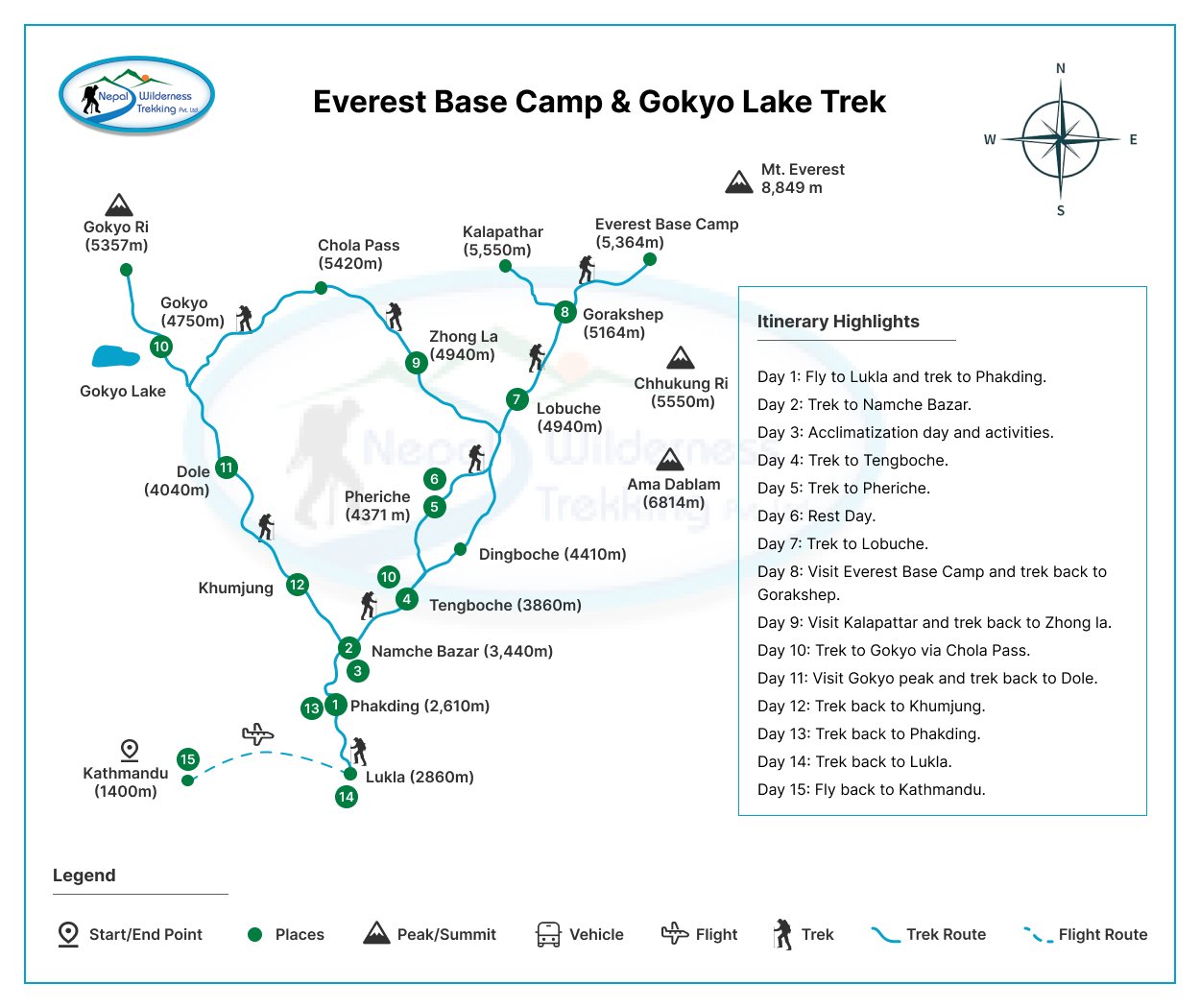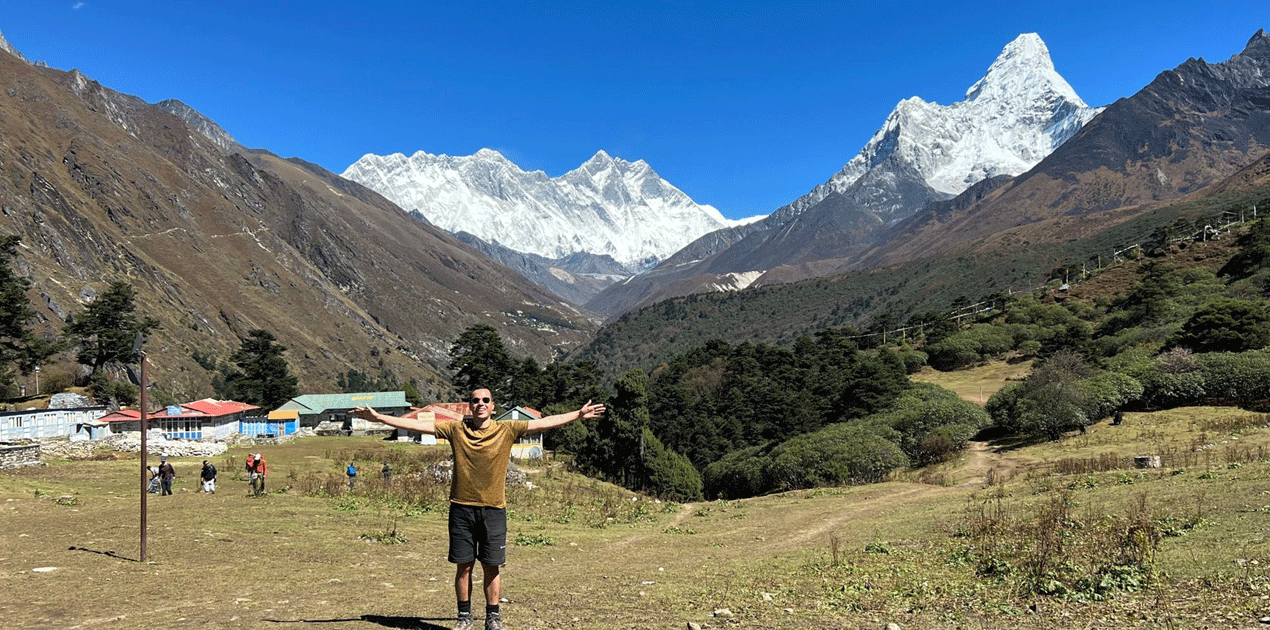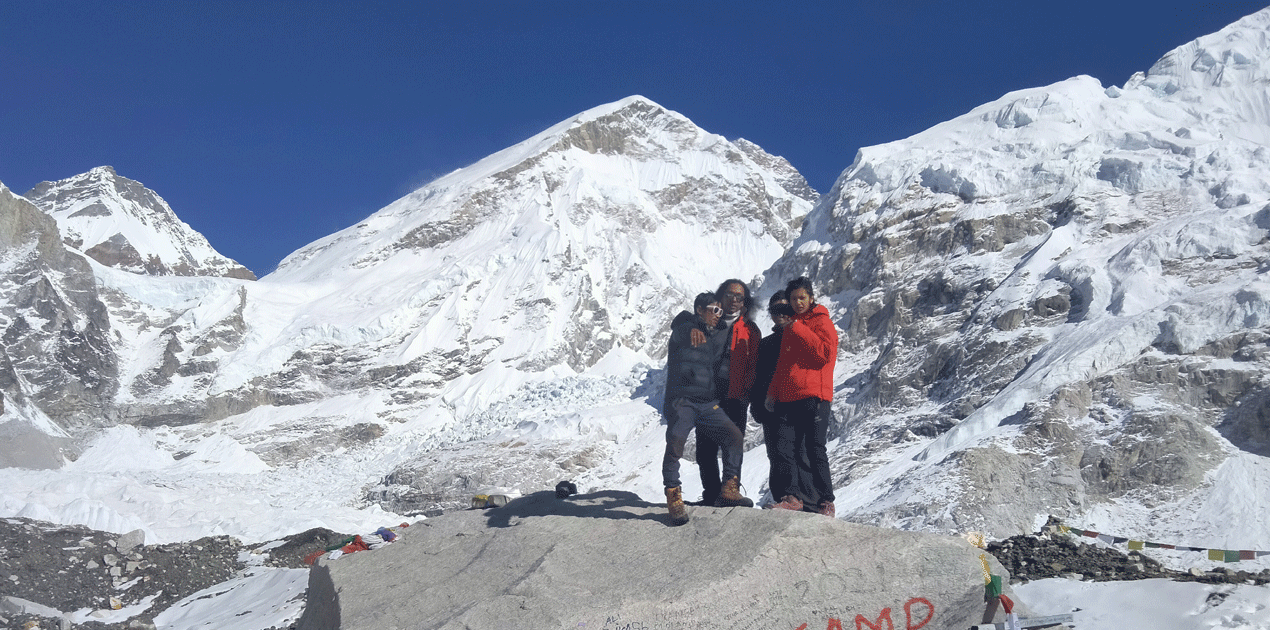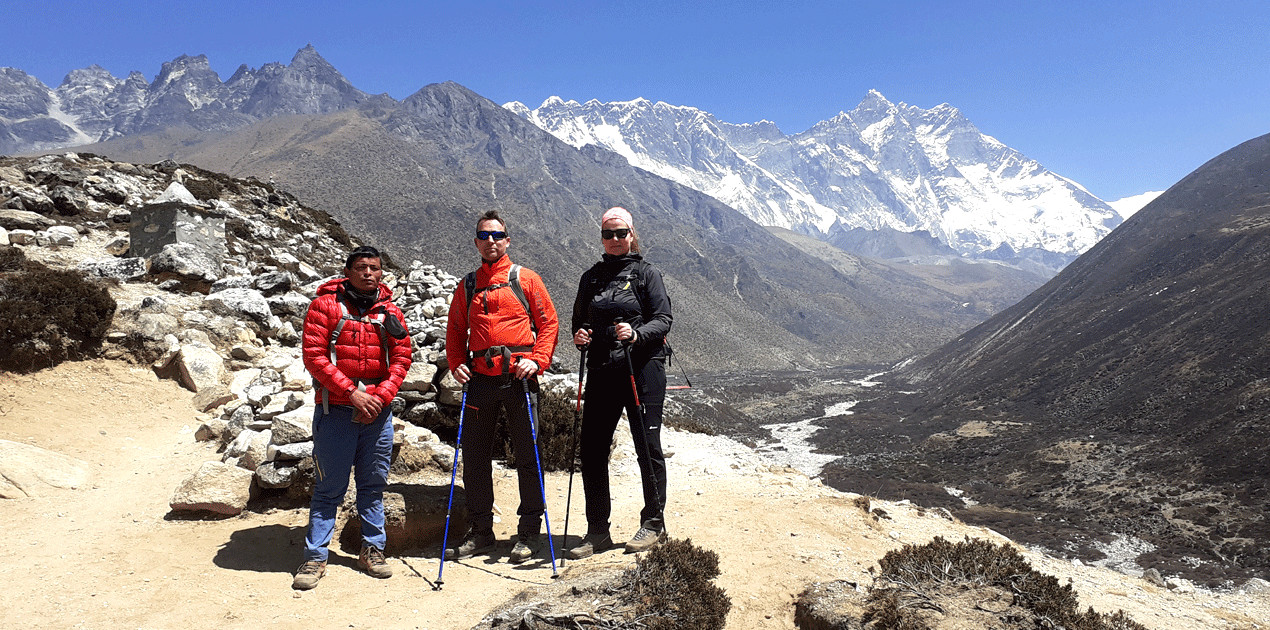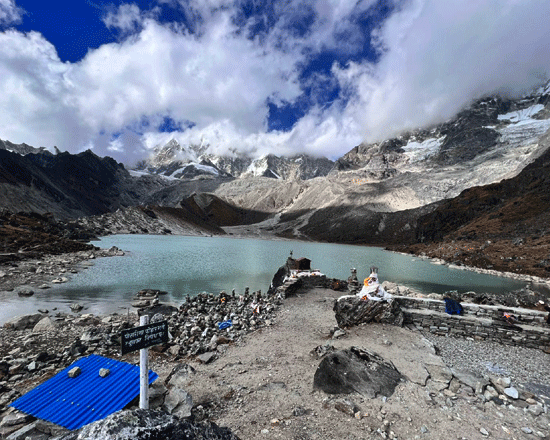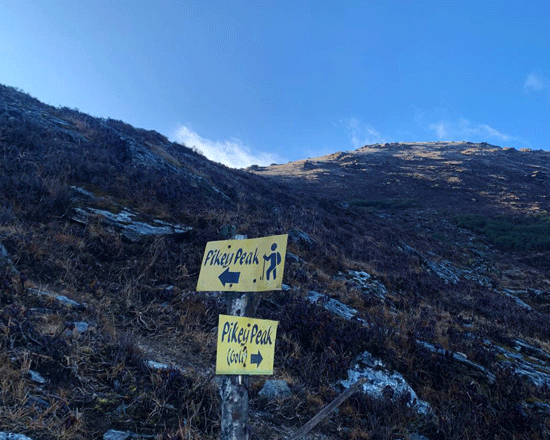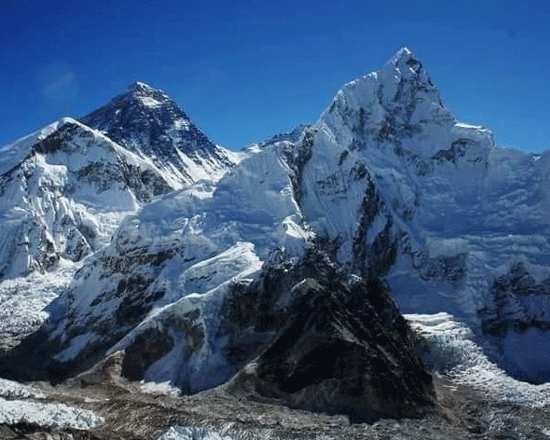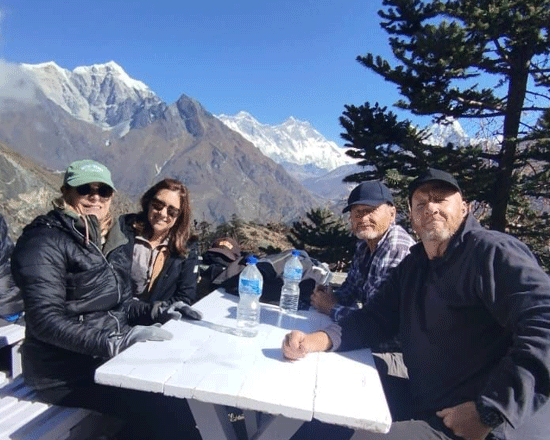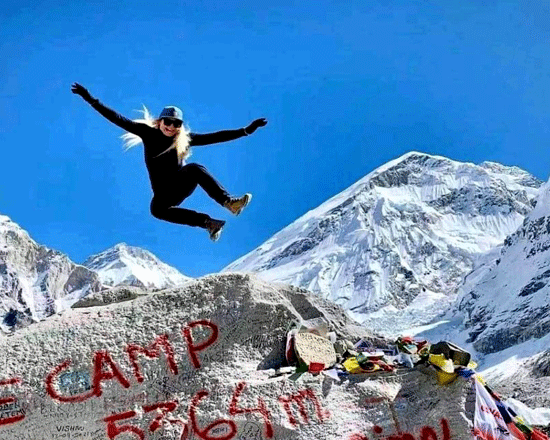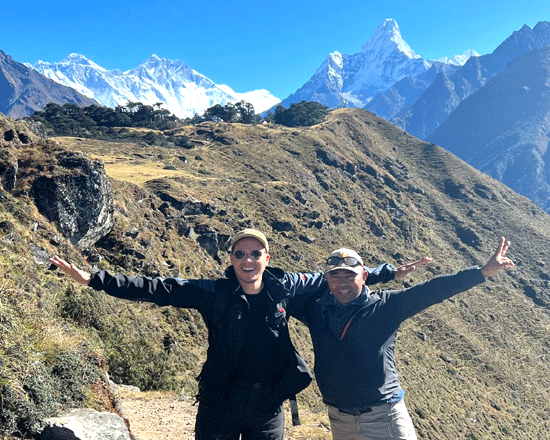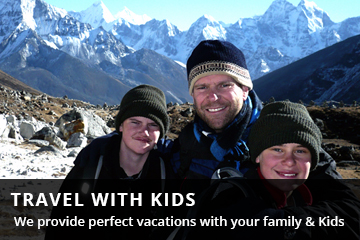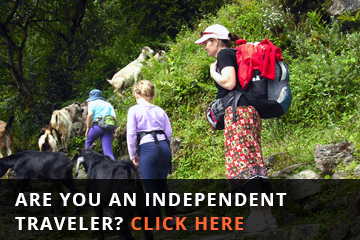Everest Chola Pass Trek
Everest Chola Pass Trek
Everest RegionTrip Facts
Since the terrain can be hard and the days long, hikers on these treks should be in good physical condition and have some previous mountain walking experience. Steep climbing may be involved, although it is never necessary to use ropes. Treks at this level can he arranged for periods of 16 to 21 days. Typically, a gradual ascent through a green river valley will lead you up to a number of high passes, where you will reach the altitude of 5416m. Often times, you will get a close insight into the Tibetan culture. Participants should expect to trek above 5416m/17872ft.
100%
Overview
Everest Chola Pass Trek 15 days package itinerary
Deep within the Khumbu region of Nepal, the Everest Chola Pass Trek is simply a testament to the allure and challenges of high-altitude trekking. This exhilarating expedition combines technical skill with breathtaking natural beauty, offering a picturesque journey through traditional Sherpa villages, rhododendron forest, and majestic Himalayan peaks like Mount Everest (8,848 meters), Lhotse (8,516 meters), Nuptse (7,861 meters), and Ama Dablam (6,812 meters) and many more peaks.
Beginning the Adventure: Kathmandu to Lukla
The journey commences with a scenic flight from Kathmandu to Tenzing Hillary Airport in Lukla (2,860 meters), A thrilling experience itself as you soar above the clouds toward the heart of the Himalayas. The flight, often described as an adventure in its own right, provides a bird’s-eye view of the sprawling Kathmandu Valley and the towering peaks that dominate the horizon. Upon landing in Lukla, the gateway to the Khumbu region, trekkers are greeted by the crisp mountain air and the bustling energy of this vibrant town.
Acclimatization and Preparation
Acclimatization is crucial as one ascends higher into the Khumbu valley. Namche Bazaar is a focal point for rest and acclimatization, where trekkers adjust to the altitude and immerse themselves in Sherpa hospitality. The town, set in a crescent-shaped amphitheater, offers panoramic views of the surrounding peaks and valleys. Trekkers often spend 1 to 2 nights here in Namche, visiting the local museums, interacting with the Sherpa people, and exploring the nearby Khumjung village, home to the famed Hillary School.
Continuing the journey, the trail leads to the Tengboche Monastery (3,867 meters), a spiritual haven settled on a ridge with commanding views of Ama Dablam, Everest, and the Khumbu Glacier. The monastery, a focal point of Sherpa culture and Tibetan Buddhism, offers a serene respite before the ascent towards higher altitudes. The daily prayers and chants of the monks create an atmosphere of peace and reflection, providing trekkers with a spiritual boost for the challenges ahead.
Gokyo Valley and Lakes
The Everest Chola Pass Trek trail diverges towards the tranquil Gokyo Valley, home to the stunning Gokyo Lakes (Thonak Lake) and the serene Dudh Pokhari (4,750 meters). This section of the Everest Chola Pass trek is a feast for the eyes, with turquoise glacial lakes set against the scenery of snow-capped peaks. Trekkers often ascend Gokyo Ri (5,357 meters), a standpoint offering unparalleled views of Cho Oyu (8,188 meters), Makalu (8,485 meters), and the glacial lakes below. The climb to Gokyo Ri is demanding but immensely rewarding, with the panorama from the summit being one of the most spectacular in the Himalayas.
The journey through the Gokyo Valley offers a glimpse into Sherpa’s life and their deep connection with the land. The small, stone-built villages dotting the valley are home to generations of Sherpas who have lived in harmony with the harsh yet beautiful environment. The hospitality of the Sherpa people, combined with the natural beauty of the Everest Base camp & Gokyo Valley, makes this part of the trek a memorable experience.
Everest Chola Pass: The Ultimate Challenge
Ascending Everest Chola Pass (5,420 meters) marks the pinnacle of the trek, a high-altitude challenge that rewards trekkers with views of Thonak Lake and the surrounding peaks. The crossing of Everest Chola Pass is a test of endurance and determination, with the trail often covered in snow and ice. Trekkers must navigate steep ascents, rocky trails, and glacial moraines, emphasizing the need for careful planning and proper equipment. The Chola Pass trek essence offers breathtaking views and a sense of achievement that is hard to match.
Everest Base Camp and Kala Patthar
The journey to Everest Base Camp is a trek through history, with every step bringing you closer to the world’s highest peak. The base camp, bustling with activity during the climbing season, offers a glimpse into the world of high-altitude mountaineering. Nearby, Kala Patthar (5,545 meters) provides a panoramic viewpoint of Mount Everest, offering a breathtaking vantage point to witness the world’s highest peak in all its glory. The sunrise view from Kala Patthar, with the first rays of sunlight illuminating the summit of Everest, is a sight that remains etched in memory.
Trekking Seasons and Considerations
The best times to undertake the Everest Chola Pass Trek are during the spring (March to May) and autumn (September to November) seasons when the weather is favorable and the skies are clear. During these times, Three Passes Trek is more busy with trekkers covering their menu because it is open to passes like Renjo La Pass, Chola Pass, And Kongma la Pass, and the local Sherpa communities celebrate festivals like Dumje and Mani Rimdu, adding cultural richness to the trekking experience. The spring season, with its blooming rhododendrons and warmer temperatures, is especially so beautiful, while the autumn season offers clear skies and crisp mountain views.
Physical fitness preparation
To undertake the Everest Chola Pass Trek, trekkers need to be physically fit. It is recommended to run for at least an hour a day for 10 to 15 days or for a month depending on your fitness level before the trek. This helps to build the individual’s hiking stamina. This preparation helps in acclimatizing to the high altitudes and ensures you are ready for the demanding terrain of the trek, including the challenging ascent of the Larke La Pass at (5,106 meters) (16,930 feet). What’s crucial is a willingness to prepare physically and mentally, and to respect the demands of the environment. Proper acclimatization ensures trekkers can fully enjoy the journey, absorbing the breathtaking landscapes and immersing themselves in the local culture. Ensure that, you bring the recommended trekking equipment list. Remember, quality trekking equipment can make your trip enjoyable, while a poor one can make it miserable.
Gear and Equipment
When it comes to equipment, it is crucial to ensure you have the necessary gear to stay warm and comfortable without overpacking. Proper trekking gear is essential for navigating the challenging terrain and fluctuating altitudes. This includes insulated pants, a down jacket, wind pants, thermal wear, sturdy trekking boots, and snow glasses. Additionally, suitable footwear is a must, especially considering the variable weather depending on the altitude and time of year. Waterproof walking boots that have been worn before the trek, along with warm socks and gaiters for winter conditions, are highly recommended. Furthermore, having loose, casual trousers and thermal leggings will provide comfort and flexibility during the trek.
Acclimatization Days
- As you ascend higher into the Everest Chola Pass region, the air pressure and oxygen levels decrease, leading to lower oxygen saturation in your blood. Consequently, this can cause altitude-related illnesses such as Acute Mountain Sickness (AMS), High Altitude Pulmonary Edema (HAPE), and High Altitude Cerebral Edema (HACE). To mitigate these risks, acclimatization is essential.
- By allowing your body time to adjust to the reduced oxygen levels, acclimatization helps minimize the likelihood of these illnesses.
- Furthermore, acclimatization days provide trekkers and guides the opportunity to monitor any symptoms of altitude sickness that may develop, such as headache, nausea, dizziness, and fatigue.
- Additionally, these rest days allow for early detection and prevention of severe conditions. As a result, acclimatization improves your physical performance at higher altitudes, reducing the rush and stress of gaining altitude quickly.
- In summary, taking time to acclimatize is a crucial aspect of the Everest Chola Pass Trek. It not only enhances safety but also ensures a more enjoyable and successful trekking experience.
Safety and Conservation Efforts
Safety is paramount in this high-altitude environment, with trekking guides from Nepal Wilderness Trekking providing expert guidance and support throughout the journey. The guides, experienced and knowledgeable, ensure that trekkers are well-prepared for the challenges of the trek. Conservation efforts in Sagarmatha National Park, a UNESCO World Heritage site, aim to protect the diverse flora and fauna, including rare species like the snow leopard, red panda, and Himalayan Thar. Moreover, Trekkers are encouraged to practice responsible trekking, minimizing their environmental impact and supporting local conservation initiatives.
Conclusion: A Trek of a Lifetime
The Everest Chola Pass Trek is not merely a physical challenge but a transformative journey through some of the world’s most spectacular landscapes. Beginning from the lively streets of Kathmandu, the trek gradually transitions into the serene trails of the Khumbu region. At each step, trekkers gain a deeper understanding of Sherpa culture, Himalayan heritage, and the enduring spirit of exploration. Whether gazing upon Mount Everest from Kala Patthar or traversing the pristine waters of Gokyo Lakes, every moment on this trek is a testament to the indomitable allure of the Himalayas.
Moreover, the Everest Chola Pass Trek or Everest basecamp trek without a flight to Lukla is an invitation to immerse oneself in the majesty of the Khumbu Himalayas, challenge one’s limits, and discover the profound beauty of this remote and enchanting region. For those who seek adventure, inspiration, and a deeper connection with nature, this trek offers an unparalleled experience. Therefore, embark on your Chola Pass Trek to create a memorable lifetime journey, as you will experience an extraordinary adventure filled with breathtaking views, cultural encounters, and personal growth.
Note
All published dates are guaranteed departures. If these dates don’t match your travel plans, we are happy to create a trip for your desired dates. Let us know what kind of trip you are looking for, and we will help make your dream destination a reality.
Detail Itinerary
- Day 01: Fly to Lukla and trek to Phakding (2,652m/8,700ft) Take an early morning flight to Lukla and start trekking to Phakding. The trail descends through beautiful landscapes and Sherpa villages.
- Day 02: Trek to Namche Bazaar (3,440m/11,283ft) Continue trekking along the Dudh Koshi River, crossing suspension bridges, and ascend to Namche Bazaar.
- Day 03: Acclimatization Day in Namche Bazaar Spend an extra day in Namche Bazaar to acclimatize. Explore the town, visit the local market, and enjoy panoramic views of the surrounding mountains.
- Day 04: Trek to Tengboche (3,860m/12,664ft) Trek through rhododendron forests and reach Tengboche. Visit the Tengboche Monastery and take in the breathtaking views of Everest and other peaks.
- Day 05: Trek to Dingboche (4,410m/14,468ft) Continue trekking to Dingboche, a small village in the Imja Valley. Enjoy the views of Ama Dablam and other Himalayan peaks.
- Day 06: Acclimatization Day in Dingboche Take a rest day in Dingboche for acclimatization. You can go on a short hike to Nagarjun Hill for stunning views of the surrounding mountains.
- Day 07: Trek to Lobuche (4,910m/16,108ft) Resume trekking towards Lobuche, walking along the moraine of the Khumbu Glacier. The views of Nuptse and other peaks become more prominent.
- Day 08: Trek to Gorak Shep (5,164m/16,942ft), Visit Everest Base Camp (5,364m/17,598ft) Trek to Gorak Shep, have lunch, and then continue to Everest Base Camp. Explore the base camp area and witness the iconic Khumbu Icefall. Return to Gorak Shep for an overnight stay.
- Day 09: Explore Kalapattar (5,545 meters). for the most stunning view of Everest, climb up in the morning before trekking back to Zong la 4830 M (5 hours walking), and spend the night at a lodge.
- Day 10: 6 hours walk to Tangnak 4843M. via Chola Pass (5420meters, overnight at the lodge
- Day 11: Trek to Gokyo (4700 meters.) 3-hour walking trek) Stay overnight at Gokyo.
- Day 12: visit Gokyo Peak (5357 meters), our highest point (four and a half hours walking), which offers sunrise and an expansive view of the mountain range. Return to Gokyo, trek back to Dole 4038M, and stay overnight at the lodge.
- Day 13: Trek to Namche Bazaar (3,440m/11,283ft) Follow the trail back to Namche Bazaar, enjoying the familiar landscapes and Sherpa villages.
- Day 14: Trek to Lukla (2,800m/9,186ft) Continue your descent to Lukla, where you'll spend the last night in the Everest region.
- Day 15: Fly back to Kathmandu Take a morning flight from Lukla to Kathmandu.
Cost Included
- Domestic flight tickets from Kathmandu to Lukla and Lukla to Kathmandu
- Italian, Chinese, Nepali, Indian, and other European foods are available three times a day (breakfast, lunch, and dinner).
- Accommodation in tea houses according to the itinerary
- Kitbag for storing your belongings
- Sleeping bag for a comfortable night's sleep on a trek in minus-25 degrees
- Everest National Park Entrance Trekking Permit
- Khumbu Pasang Lhamu Rural Municipality Entrance Permit
- Experienced English-speaking trekking guide licensed by the government, familiar with the area.
- One porter for every two to three participants. (Note: An additional cost applies for solo clients requiring a porter.)
- Guide, and Porter meals, accommodation, salary, and insurance
- Necessary paper works, all government, and local taxes
- A certificate of appreciation from Nepal wilderness trekking after a successful trek
Cost Excluded
- Airfare for international flights
- Upon arrival at Tribhuwan International Airport, Nepal entry visa fees vary by duration (15 days - $25-30, 30 days
- Accommodations and meals in Kathmandu before and after our journey
- Personal equipment for high and cold temperatures
- Emergency high-altitude rescue and evacuation are covered by travel insurance
- All beverages, Soft and coffee table drinks such as coke, beer,
- Drinking water/mineral water, Dessert, etc. Hot shower, laundry
- Tip for guide and porter
- Excluded are all costs and expenses not listed under "cost includes"
- Inclusion of costs or delays beyond the control of the management, such as landslides, weather conditions, itinerary modifications due to safety concerns, illness, changes in government policies, strikes, etc.
| Trip Dates | Trip Price | Confirmed Pax | Trip Status | |
|---|---|---|---|---|
| April 18, 2025 | US$ 1480 | Join a Group | Book Now | |
| April 22, 2025 | US$ 1480 | Join a Group | Book Now | |
| April 25, 2025 | US$ 1480 | Join a Group | Book Now | |
| April 27, 2025 | US$ 1480 | Join a Group | Book Now | |
| April 30, 2025 | US$ 1480 | Join a Group | Book Now | |
| May 7, 2025 | US$ 1480 | Join a Group | Book Now | |
| May 10, 2025 | US$ 1480 | Join a Group | Book Now | |
| May 14, 2025 | US$ 1480 | Join a Group | Book Now | |
| May 18, 2025 | US$ 1480 | Join a Group | Book Now | |
| May 22, 2025 | US$ 1480 | Join a Group | Book Now | |
| May 26, 2025 | US$ 1480 | Join a Group | Book Now | |
| May 30, 2025 | US$ 1480 | Join a Group | Book Now | |
| June 3, 2025 | US$ 1480 | Join a Group | Book Now | |
| June 8, 2025 | US$ 1480 | Join a Group | Book Now | |
| June 12, 2025 | US$ 1480 | Join a Group | Book Now | |
| June 16, 2025 | US$ 1480 | Join a Group | Book Now | |
| June 20, 2025 | US$ 1480 | Join a Group | Book Now | |
| June 24, 2025 | US$ 1480 | Join a Group | Book Now | |
| June 28, 2025 | US$ 1480 | Join a Group | Book Now | |
| June 30, 2025 | US$ 1480 | Join a Group | Book Now | |
| July 3, 2025 | US$ 1480 | Join a Group | Book Now | |
| July 8, 2025 | US$ 1480 | Join a Group | Book Now | |
| July 12, 2025 | US$ 1480 | Join a Group | Book Now | |
| July 18, 2025 | US$ 1480 | Join a Group | Book Now | |
| July 22, 2025 | US$ 1480 | Join a Group | Book Now | |
| July 26, 2025 | US$ 1480 | Join a Group | Book Now | |
| July 30, 2025 | US$ 1480 | Join a Group | Book Now | |
| August 3, 2025 | US$ 1480 | Join a Group | Book Now | |
| August 8, 2025 | US$ 1480 | Join a Group | Book Now | |
| August 12, 2025 | US$ 1480 | Join a Group | Book Now | |
| August 16, 2025 | US$ 1480 | Join a Group | Book Now | |
| August 20, 2025 | US$ 1480 | Join a Group | Book Now | |
| August 25, 2025 | US$ 1480 | Join a Group | Book Now | |
| August 30, 2025 | US$ 1480 | Join a Group | Book Now | |
| September 3, 2025 | US$ 1480 | Join a Group | Book Now | |
| September 8, 2025 | US$ 1480 | Join a Group | Book Now | |
| September 12, 2025 | US$ 1480 | Join a Group | Book Now | |
| September 16, 2025 | US$ 1480 | Join a Group | Book Now | |
| September 20, 2025 | US$ 1480 | Join a Group | Book Now | |
| September 24, 2025 | US$ 1480 | Join a Group | Book Now | |
| September 27, 2025 | US$ 1480 | Join a Group | Book Now | |
| September 30, 2025 | US$ 1480 | Join a Group | Book Now | |
| October 3, 2025 | US$ 1480 | Join a Group | Book Now | |
| October 8, 2025 | US$ 1480 | Join a Group | Book Now | |
| October 12, 2025 | US$ 1480 | Join a Group | Book Now | |
| October 16, 2025 | US$ 1480 | Join a Group | Book Now | |
| October 24, 2025 | US$ 1480 | Join a Group | Book Now | |
| October 30, 2025 | US$ 1480 | Join a Group | Book Now | |
| November 10, 2025 | US$ 1480 | Join a Group | Book Now | |
| November 15, 2025 | US$ 1480 | Join a Group | Book Now | |
| November 20, 2025 | US$ 1480 | Join a Group | Book Now | |
| November 24, 2025 | US$ 1480 | Join a Group | Book Now | |
| November 28, 2025 | US$ 1480 | Join a Group | Book Now | |
| December 3, 2025 | US$ 1480 | Join a Group | Book Now | |
| December 7, 2025 | US$ 1480 | Join a Group | Book Now | |
| December 11, 2025 | US$ 1480 | Join a Group | Book Now | |
| December 15, 2025 | US$ 1480 | Join a Group | Book Now | |
| December 19, 2025 | US$ 1480 | Join a Group | Book Now | |
| December 23, 2025 | US$ 1480 | Join a Group | Book Now | |
| December 27, 2025 | US$ 1480 | Join a Group | Book Now | |
| December 31, 2025 | US$ 1480 | Join a Group | Book Now | |
| January 4, 2026 | US$ 1480 | Join a Group | Book Now | |
| January 8, 2026 | US$ 1480 | Join a Group | Book Now | |
| January 12, 2026 | US$ 1480 | Join a Group | Book Now | |
| January 16, 2026 | US$ 1480 | Join a Group | Book Now | |
| January 20, 2026 | US$ 1480 | Join a Group | Book Now | |
| January 24, 2026 | US$ 1480 | Join a Group | Book Now | |
| January 28, 2026 | US$ 1480 | Join a Group | Book Now | |
| February 2, 2026 | US$ 1480 | Join a Group | Book Now | |
| February 6, 2026 | US$ 1480 | Join a Group | Book Now | |
| February 12, 2026 | US$ 1480 | Join a Group | Book Now | |
| February 16, 2026 | US$ 1480 | Join a Group | Book Now | |
| February 20, 2026 | US$ 1480 | Join a Group | Book Now | |
| February 24, 2026 | US$ 1480 | Join a Group | Book Now | |
| February 28, 2026 | US$ 1480 | Join a Group | Book Now | |
| March 2, 2026 | US$ 1480 | Join a Group | Book Now | |
| March 6, 2026 | US$ 1480 | Join a Group | Book Now | |
| March 10, 2026 | US$ 1480 | Join a Group | Book Now | |
| March 14, 2026 | US$ 1480 | Join a Group | Book Now | |
| March 19, 2026 | US$ 1480 | Join a Group | Book Now | |
| March 25, 2026 | US$ 1480 | Join a Group | Book Now | |
| March 30, 2026 | US$ 1480 | Join a Group | Book Now | |
| April 2, 2026 | US$ 1480 | Join a Group | Book Now | |
| April 6, 2026 | US$ 1480 | Join a Group | Book Now | |
| April 10, 2026 | US$ 1480 | Join a Group | Book Now | |
| April 14, 2026 | US$ 1480 | Join a Group | Book Now | |
| April 18, 2026 | US$ 1480 | Join a Group | Book Now | |
| April 23, 2026 | US$ 1480 | Join a Group | Book Now | |
| April 28, 2026 | US$ 1480 | Join a Group | Book Now | |
| May 2, 2026 | US$ 1480 | Join a Group | Book Now | |
| May 6, 2026 | US$ 1480 | Join a Group | Book Now | |
| May 10, 2026 | US$ 1480 | Join a Group | Book Now | |
| May 15, 2026 | US$ 1480 | Join a Group | Book Now | |
| May 20, 2026 | US$ 1480 | Join a Group | Book Now | |
| May 25, 2026 | US$ 1480 | Join a Group | Book Now | |
| May 30, 2026 | US$ 1480 | Join a Group | Book Now | |
| June 3, 2026 | US$ 1480 | Join a Group | Book Now | |
| June 8, 2026 | US$ 1480 | Join a Group | Book Now | |
| June 12, 2026 | US$ 1480 | Join a Group | Book Now | |
| June 16, 2026 | US$ 1480 | Join a Group | Book Now | |
| June 20, 2026 | US$ 1480 | Join a Group | Book Now | |
| June 25, 2026 | US$ 1480 | Join a Group | Book Now | |
| June 30, 2026 | US$ 1480 | Join a Group | Book Now | |
| July 3, 2026 | US$ 1480 | Join a Group | Book Now | |
| July 8, 2026 | US$ 1480 | Join a Group | Book Now | |
| July 12, 2026 | US$ 1480 | Join a Group | Book Now | |
| July 16, 2026 | US$ 1480 | Join a Group | Book Now | |
| July 22, 2026 | US$ 1480 | Join a Group | Book Now | |
| July 26, 2026 | US$ 1480 | Join a Group | Book Now | |
| July 30, 2026 | US$ 1480 | Join a Group | Book Now | |
| August 5, 2026 | US$ 1480 | Join a Group | Book Now | |
| August 10, 2026 | US$ 1480 | Join a Group | Book Now | |
| August 20, 2026 | US$ 1480 | Join a Group | Book Now | |
| August 25, 2026 | US$ 1480 | Join a Group | Book Now | |
| August 30, 2026 | US$ 1480 | Join a Group | Book Now | |
| September 5, 2026 | US$ 1480 | Join a Group | Book Now | |
| September 10, 2026 | US$ 1480 | Join a Group | Book Now | |
| September 14, 2026 | US$ 1480 | Join a Group | Book Now | |
| September 18, 2026 | US$ 1480 | Join a Group | Book Now | |
| September 24, 2026 | US$ 1480 | Join a Group | Book Now | |
| September 29, 2026 | US$ 1480 | Join a Group | Book Now | |
| October 3, 2026 | US$ 1480 | Join a Group | Book Now | |
| October 8, 2026 | US$ 1480 | Join a Group | Book Now | |
| October 12, 2026 | US$ 1480 | Join a Group | Book Now | |
| October 16, 2026 | US$ 1480 | Join a Group | Book Now | |
| October 20, 2026 | US$ 1480 | Join a Group | Book Now | |
| October 24, 2026 | US$ 1480 | Join a Group | Book Now | |
| October 28, 2026 | US$ 1480 | Join a Group | Book Now | |
| October 30, 2026 | US$ 1480 | Join a Group | Book Now | |
| November 5, 2026 | US$ 1480 | Join a Group | Book Now | |
| November 8, 2026 | US$ 1480 | Join a Group | Book Now | |
| November 13, 2026 | US$ 1480 | Join a Group | Book Now | |
| November 17, 2026 | US$ 1480 | Join a Group | Book Now | |
| November 19, 2026 | US$ 1480 | Join a Group | Book Now | |
| November 23, 2026 | US$ 1480 | Join a Group | Book Now | |
| November 27, 2026 | US$ 1480 | Join a Group | Book Now | |
| November 30, 2026 | US$ 1480 | Join a Group | Book Now | |
| December 5, 2026 | US$ 1480 | Join a Group | Book Now | |
| December 8, 2026 | US$ 1480 | Join a Group | Book Now | |
| December 12, 2026 | US$ 1480 | Join a Group | Book Now | |
| December 16, 2026 | US$ 1480 | Join a Group | Book Now | |
| December 19, 2026 | US$ 1480 | Join a Group | Book Now | |
| December 22, 2026 | US$ 1480 | Join a Group | Book Now | |
| December 26, 2026 | US$ 1480 | Join a Group | Book Now | |
| December 30, 2026 | US$ 1480 | Join a Group | Book Now |
Trip Map
